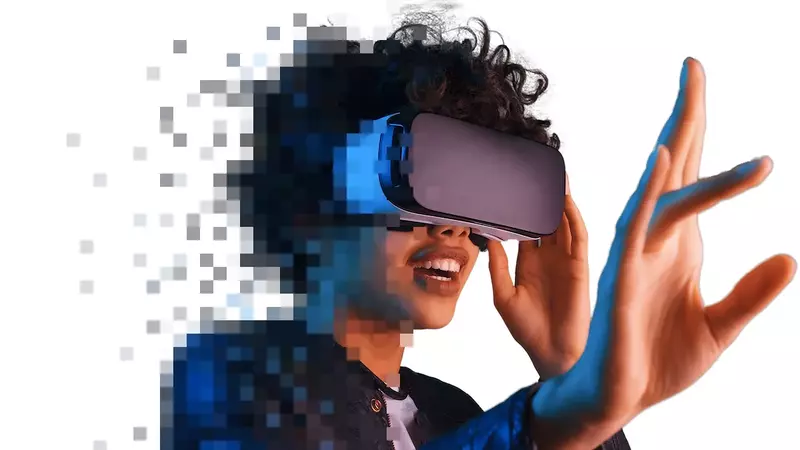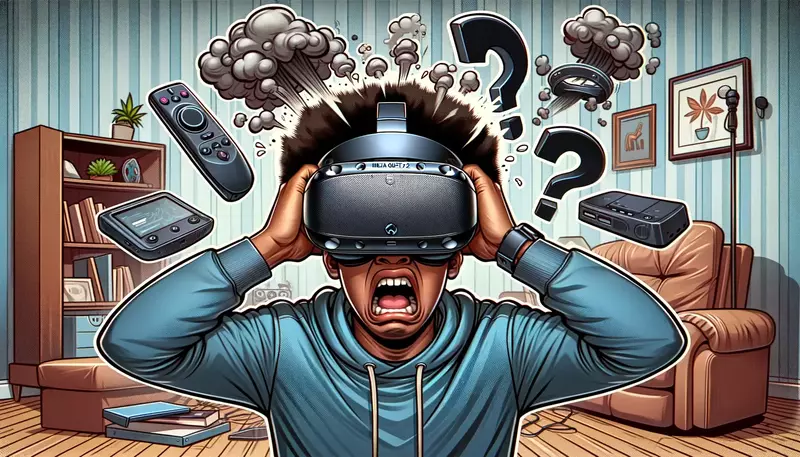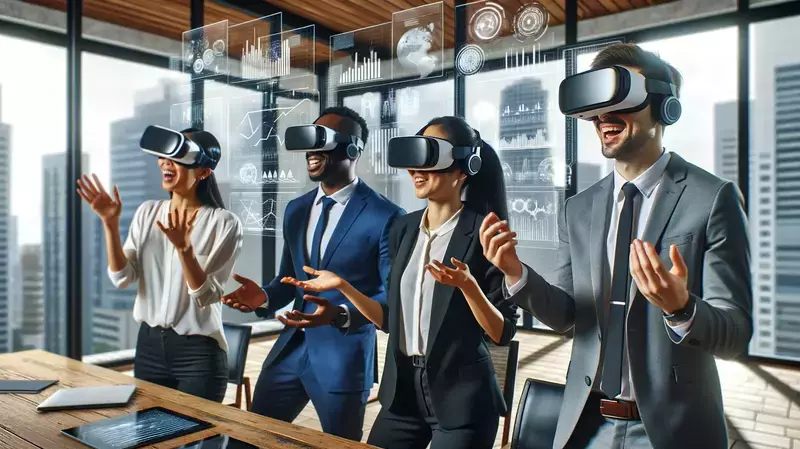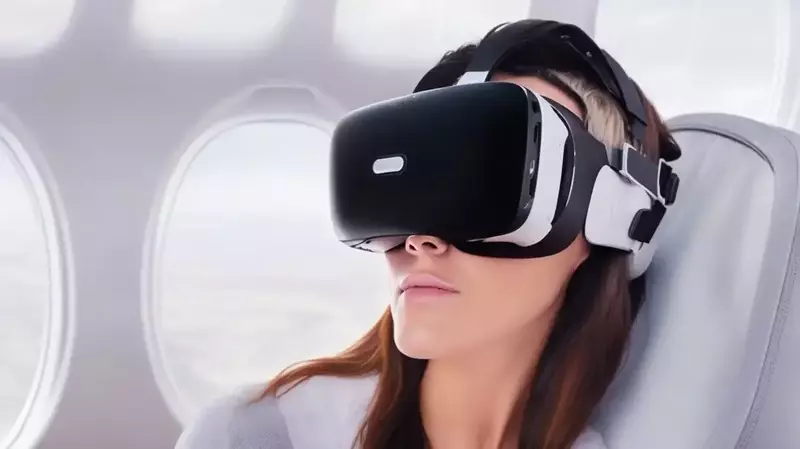This site contains affiliate links to products, and we may receive a commission for purchases made through these links.
Have you ever wondered who discovered virtual reality? From its humble beginnings to today’s advanced technology, VR has been a long journey. Going back centuries, the idea of Virtual Reality has been a continuous journey from its primitive beginnings to today’s cutting-edge technology.
It all began with primitive attempts at creating an immersive environment for users that would allow them to experience something beyond their own physical world. Today, there are many different applications and advancements in this field, but it was not always so clear-cut – who discovered virtual reality?
In this blog post we will explore the history behind this fascinating technology from early developments through modern advances right up until recent times.

History of Virtual Reality
Virtual reality (VR) has been around since the 1950s when Morton Heilig developed the Sensorama Simulator. The simulator was a machine that combined sight, sound, smell, and motion to create an immersive experience for viewers.
It featured three-dimensional stereoscopic images with stereo sound and odor emitters. Heilig is credited as one of the first pioneers in virtual reality technology, and his invention paved the way for modern VR systems.
Early Developments in VR:
Following Heilig’s work on the Sensorama Simulator, other inventors began experimenting with ways to make virtual reality more interactive.
In 1968 Ivan Sutherland created “The Sword of Damocles,” which was a head-mounted display system connected to a computer program that allowed users to interact with 3D graphics generated by the program.
This was followed by Jaron Lanier’s development of VPL Research Inc., which sold various products related to virtual reality, such as gloves and goggles equipped with sensors that tracked user movement.
Recent times have seen a proliferation of virtual reality advancements due to the higher computing power and graphical processing capacities.
Companies like Oculus and now Meta, HTC, and Sony have released consumer-level headsets that allow users to explore realistic 3D environments while being immersed within them using specialized controllers or hand-tracking devices like Leap Motion Controller or Manus Prime 1 Gloves & Trackers .
Furthermore, Microsoft is innovating by creating a hybrid of augmented and virtual realities in the form of HoloLens 2. This new technology offers users more control over their surroundings than traditional VR does currently.
VR’s past is an intriguing one, abundant with originality and trial-and-error. Early VR advances have enabled us to witness the remarkable progress of this technology since its inception.
Early Developments in VR
In the 1960s, Ivan Sutherland and his student Bob Sproull developed the first head-mounted display system, known as “The Sword of Damocles”.
This device was revolutionary for its time, allowing users to experience a 3D environment with motion tracking.
The user was able to shift their head within the simulated world and engage with items displayed on a monitor in front of them. This milestone in VR technology provided a foundation for the more sophisticated systems available today, such as Oculus Rift and HTC Vive.
It paved the way for more advanced systems such as Oculus Rift and HTC Vive which are used today by gamers and explorers alike.
Sutherland’s invention was far from perfect. It had several drawbacks, including a limited field of view, poor image quality, lack of haptic feedback, and no sound support. Despite these shortcomings, it still provided an immersive experience that showed great potential for future VR applications.
Another major advancement came in 1987 when Jaron Lanier founded VPL Research Inc., one of the first companies to research and develop VR technologies.
They created a number of products, such as data gloves, that allowed users to control virtual environments using hand gestures. They also introduced a range of software tools designed specifically for creating interactive 3D worlds.
These tools made it easier than ever before to create realistic simulations within computers or game consoles, which opened up new possibilities for gaming experiences like never before seen on home consoles at the time.
Early advances in VR have established the basis for numerous of today’s techs, and it is apparent that this innovation will persist to expand. Moving on from these pioneering steps, modern VR developments are pushing boundaries even further.
Modern Developments in VR
Jaron Lanier, in the ’90s, started VPL Research and achieved noteworthy advances in virtual reality applications. Jaron Lanier’s research team pioneered the design of an HMD that enabled users to explore 3D virtual worlds, as well as a data glove for manipulating objects in real time.
They also developed a “data glove” that allowed users to interact with virtual objects by manipulating their hands in real time. These early developments laid the foundation for many modern VR systems today.
In the mid-1990s, various companies such as Nintendo and Sega released their own HMDs in an attempt to capitalize on the growing interest in VR technology; however, these products were ultimately unsuccessful due to technical limitations. However, these products were not as successful as expected due to limited hardware capabilities at the time.
Recently, due to improved processing power and the advent of capable graphics cards for rendering 3D visuals on small screens, we have seen genuine progress in this area.
Today’s modern HMDs offer much more than just basic gaming experiences; they afford users the opportunity to explore digital landscapes, experience realistic visuals and movements while interacting with virtual objects such as tools or weapons within a game environment, and even provide medical simulations designed to help train surgeons and other healthcare professionals.
Additionally, augmented reality (AR) overlays have been incorporated into some devices which enable people who are physically disabled or confined indoors due to illness or injury an avenue of escape from their current situation – allowing them to view real-world objects through a headset without being tethered down by wires so that they can safely immerse themselves in new places all from the comfort of their own home during times when social distancing is necessary.
Keywords: Advanced Level Professional, Idioms & Colloquialisms, Active Voice, Proper Grammar & Spelling
Modern VR developments have opened up a world of possibilities, but there is still much to be discovered. Recent progress in VR has enabled us to explore even more immersive realities.
Recent Advances in VR
Recent advances in VR have made it possible to experience a plethora of applications and uses. Gaming has been revolutionized by virtual reality technology, allowing users to feel as if they are truly in the game world.
Education is also being revolutionized by VR technology, enabling students to explore distant locations or participate in simulations without ever leaving the classroom.
The medical field is taking advantage of this technology too, using it for training purposes and even for surgeries that require precision and accuracy.
VR has been used extensively in marketing campaigns as well; companies are able to create an interactive 3D space where customers can view products from all angles before making a purchase decision.
Additionally, real estate agents are now utilizing virtual tours so potential buyers can “walk” through homes without physically visiting them first. Microsoft is creating mixed-reality headsets that enable users to view digital objects combined with their physical environment, producing novel experiences combining actuality and imagination.
The possibilities of virtual reality seem endless at this point; developers continue finding new ways to use this innovative technology every day.
For example, some museums are beginning to incorporate VR into their exhibits – allowing visitors an opportunity to learn more about certain artifacts or places while still feeling immersed in the experience itself.
Similarly, architects can use VR tools when designing buildings so they can get a better understanding of how different elements will fit together before construction begins.
Overall, recent advancements in virtual reality have allowed us access into entirely new worlds filled with opportunities for exploration and discovery. Given its potential for providing both enjoyment and educational advantages, it is unsurprising that virtual reality has become increasingly popular.
FAQs in Relation to Who Discovered Virtual Reality?
Who discovered virtual reality?
The invention of virtual reality is credited to Morton Heilig, an American cinematographer and inventor. Morton Heilig’s innovation in the 1950s, Sensorama, was a multi-sensory experience aimed at stimulating all senses to produce an immersive viewing experience. This concept eventually led him to develop the first head mounted display (HMD) system known as “The Telesphere Mask”. The device featured stereo sound, 3D graphics and binocular vision with motion tracking capabilities. Heilig’s work has since become the foundation upon which modern virtual reality systems are based on today.
Who invented VR in the 21st century?
Palmer Luckey, an American entrepreneur, is credited with inventing virtual reality (VR) in the 21st century. In 2010, Palmer Luckey set up Oculus VR with the ambition of constructing a cost-effective and attainable head-mounted display for engaging gaming. His work eventually led to the creation of the Oculus Rift, a popular consumer virtual reality headset released in 2016. The success of this product has helped propel VR into mainstream use, revolutionizing gaming and other industries alike.
Who invented virtual technology?
In the 1950s, he developed a prototype for what would become known as the Sensorama Simulator – a machine that could simulate 3D environments with audio-visual effects. This was followed by his Telesphere Mask in 1960, which had stereoscopic lenses and motion tracking capabilities. These pioneering creations served as a basis for modern VR tech and have enabled its widespread usage today.
Why did Ivan Sutherland invent virtual reality?
Ivan Sutherland invented virtual reality in 1965 to create an immersive, interactive experience for users. He devised a head-mounted device, enabling users to engage with a simulated environment created by the computer. Sutherland’s invention set the stage for modern VR to expand into 3D gaming, medical simulations and military training exercises. Sutherland’s pioneering work has revolutionized how we think about digital spaces and continues to shape our understanding of this ever-evolving field today.
Conclusion
Morton Heilig’s pioneering of Sensorama in 1962 marks the start of virtual reality’s journey, which has since seen tremendous progress to its current state.
From the early days when Morton Heilig created Sensorama in 1962 to modern day advancements, VR technology continues to evolve and expand our understanding of how it can be used for entertainment and educational purposes. Who discovered virtual reality?
While many people have made contributions over the years, it was ultimately Morton Heilig who first conceived this revolutionary concept back in 1962 that would eventually lead us into an entirely new realm of exploration and experience.
Unlock the secrets of virtual reality and discover who first pioneered this revolutionary technology. Take a journey with us to explore its past, present, and future potential!
!! For more information about the different VR headsets on the market, check out this product specification list.

Espen
Espen is the Director of PursuitMeta and has written extensively about Virtual Reality and VR Headsets for years. He is a consumer product expert and has personally tested VR Headsets for the last decade.




Leave a Reply